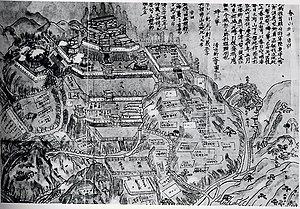Kasugayama Castle
| Kasugayama Castle | |
|---|---|
| 春日山城 | |
| Jōetsu, Niigata, Japan | |

An old print showing Kasugayama Castle
|
|
| Type | Japanese castle |
| Site information | |
| Controlled by | Nagao clan, Uesugi clan, Hori clan |
| Condition | Ruins; only earthwork walls and dry moat remain |
| Site history | |
| Built | Year Unknown |
| Built by | Nagao clan |
| In use | until 1607 |
| Garrison information | |
| Past commanders |
Nagao Tamekage, Uesugi Kenshin, Uesugi Kagekatsu |
Kasugayama Castle (春日山城 Kasugayama-jō?) was the primary fortress of the Japanese warlord Uesugi Kenshin during the Sengoku period. It is situated in what is now the city of Jōetsu, Niigata prefecture, and was originally built and ruled by the Nagao clan. It is listed on Japan's Top 100 Castles list due to its significance in culture, history and region.
There was an older castle on this site that dates to the 14th century, but there's no certain information about it. The Kasugayama castle was probably built by Nagao Tamekage, and then was inherited by Nagao Harukage. Uesugi Kenshin, his younger brother who was originally named Nagao Kagetora, became the lord of the castle in 1548. This castle was Uesugi Kenshin's departure point in his engagement with Takeda Shingen in the 1561 Battle of Kawanakajima.
After his death in 1578, his adopted son Uesugi Kagekatsu gained control of it, after a brief series of battles with another son Uesugi Kagetora, over the inheritance. Twenty years later, as Kagekatsu moved to Aizu, the Hori clan became the lords of Kasugayama; but they also decided it was not a good place to rule from, so they built a new castle at Fukushima and, in 1607, Kasugayama Castle became deserted.
The castle is unofficially called Hachigamine Castle, the name Kasuga (literally "spring day") coming from a connection to Kasuga-taisha, a major Shinto shrine shrine in Nara. The castle and its history were mentioned by Takizawa Bakin, and Yamazaki Yoshishige in Tanki manroku.
...
Wikipedia
